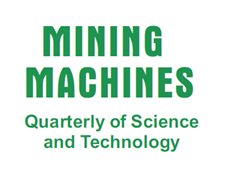Tejszerska D., Turewicz K.
Identification of dynamic load of the hydraulic leg
Szyguła M., Mazurek K., Madejczyk W.
Powered roof supports manufactured by the GLINIK company as the equipment planned for longwall faces in the Polish mining industry till 2010
Ziara A., Ślusarz R., Kret A.
Factors which influence proper operation of hydraulic system of the powered roof support
Potempa J., Wojtacha M.
Modified version of ZSHP Control Assembly for pneumatic brakes
Barańska H., Kowal L., Materzok A.
Analysis of the drum crusher operation in a mine producing coal fines for the power industry
Pyc A., Matusiak P.
Operational safety management of the powered roof support
Jaszczuk M., Markowicz J., Szweda S., Meder A.
Using virtual technology in a reconstruction of accidents in the mining industry
Winkler T., Michalak D., Bojara S., Jaszczyk Ł.
Modelling of the Koepe pulley loaded dynamically
Tejszerska D., Turewicz K.
S u m m a r y
Example of the K-6000 Koepe pulley strength calculations by using FEM method were presented. Boundary conditions for FEM strength calculations were determined on the basis of dynamic analyses with a help of electro-mechanical dynamical model of the mining shaft hoisting machine. Combination of dynamic analyses based on electro-mechanical mathematical models of the mining shaft hoisting machine with the FEM models enables to improve present calculation methods used for Koepe pulleys of the mining shaft hoisting machines.
Identification of dynamic load of the hydraulic leg
Szyguła M., Mazurek K., Madejczyk W.
S u m m a r y
At present, laboratory testing of the hydraulic legs is carried out due to the requirements of the PN-EN 1804-2 Standard. Only one load parameter is recorded during testing irrespectively to the method used – a pressure in an under-piston area at the typical leg terminal. Time process and results of dynamic testing carried out on an explosive stand with few pressure measuring points were given. Hydraulic leg of the powered roof support equipped with additional terminals and measuring channels was the testing object. The employed testing method enabled to study, in a better way, a behaviour of the hydraulic fluid during leg loading as well as to identify dynamic loads in a result of computer model calculations.
Powered roof supports manufactured by the GLINIK company as the equipment planned for longwall faces in the Polish mining industry till 2010
Ziara A., Ślusarz R., Kret A.
S u m m a r y
Development trends for longwall roof supports as the machines for longwall faces equipping, planned to be installed in the Polish mines till 2010, were discussed on an example of GLINIK powered roof supports.
Factors which influence proper operation of hydraulic system of the powered roof support
Potempa J., Wojtacha M.
S u m m a r y
Basing on own studies, it was found that the hydraulic system is a main reason of roof support failures. Problems with life of hydraulic components have arisen together with an installation of cylinders of a diameter greater than 300 mm and pumps of volume flow Qv greater than 150 l/min. Now it is common to use the legs of very high load-bearing capacity, what means high diameters of cylinders. Rate of pressure grow increased in over-piston and under-piston areas of legs, especially during their lowering. The problem is important especially when a heavy piston rod is not moving yet and overflow valve is far from the receiver. Apart from that, line of hydraulic medium supply have been extended. Thus, it is suggested to make essential changes in a hydraulic system of powered roof support control. Mines and pump producers should be convinced to this idea. Some important problems, which have an impact on a proper operation of roof support and life of its components were presented.
Modified version of ZSHP Control Assembly for pneumatic brakes
Barańska H., Kowal L., Materzok A.
S u m m a r y
Improved version of electro-pneumatic ZSHP Control Assembly for pneumatic brakes used in the hoisting machines with pneumatic brake drives was given. The history of assembly development, its advantages and scale of implementation were presented.
Analysis of the drum crusher operation in a mine producing coal fines for the power industry
Pyc A., Matusiak P.
S u m m a r y
Analysis of the drum crusher operation in a division of raw coal preparation in the coal processing plant, survey and analysis of repair works and of preventive measures which protects against failures were a subject of the paper. Location and a significance of drum crusher in a processing line decided about a selection of the machine as the eventual failure of the machine will cause a stop of the whole production line.
Operational safety management of the powered roof support
Jaszczuk M., Markowicz J., Szweda S., Meder A.
S u m m a r y
Problem of improvement of operational safety of the powered roof support by completing the components of comparable degree of wear is a discussion subject. Necessity of determination of Aw coefficient for each component of the support, and not only for the eldest one was stated. Method of using the electronic identification system for powered roof support components and recording the time and condition of their operation was suggested to support the process of equipping the longwall face with machines.
Using virtual technology in a reconstruction of accidents in the mining industry
Winkler T., Michalak D., Bojara S., Jaszczyk Ł.
S u m m a r y
The method of visualization of accidents in the mining industry using virtual technology was presented. The presented method allow for a reconstruction of accidents and preparation of the materials needed for trainings in work safety procedures.





 Badanie bezpieczeństwa wyrobów
Badanie bezpieczeństwa wyrobów Klaster Maszyn Górniczych
Klaster Maszyn Górniczych